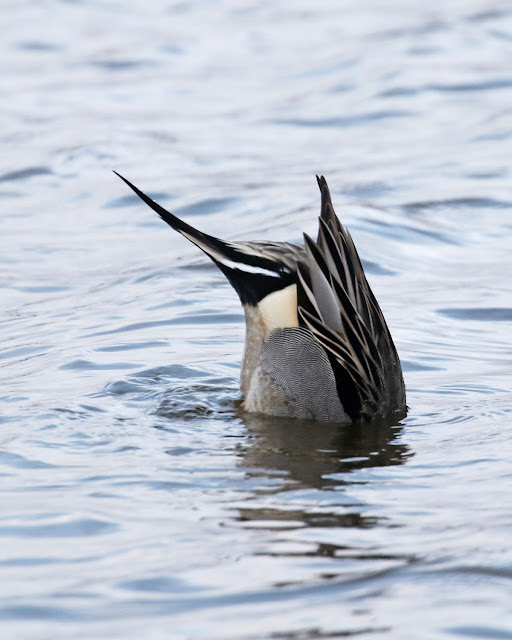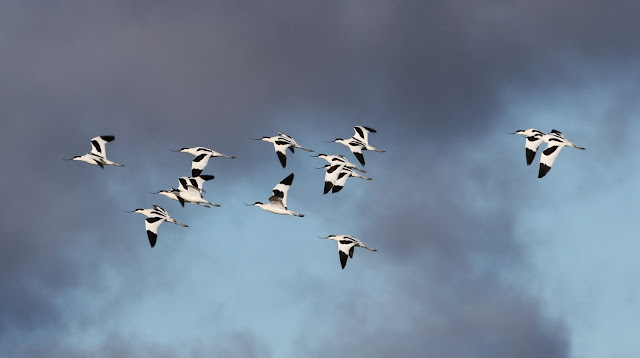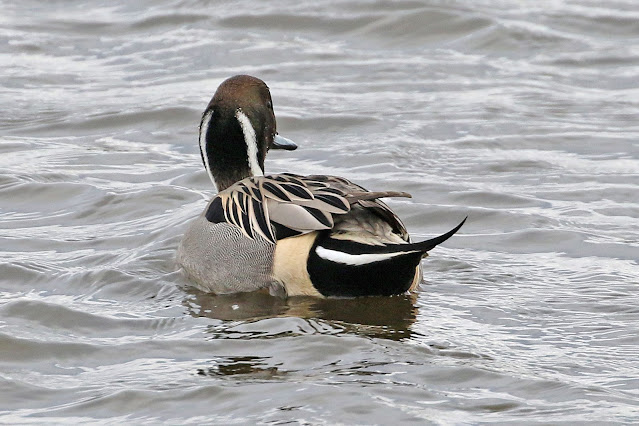I walked down the west side of the Old Tip as Robin's sang from the bushes. Ahead I picked up a large bird drifting slowly across the Fishtail Lagoon, as it dipped and twisted I realised it was a Marsh Harrier, a male bird that sent up all the duck that were in the marsh, whistles filled the air as the Wigeon and Teal scattered and others just moved quickly into the open water. The Harrier continued on across the marsh and disappeared as it moved across the new tip.
There are viewing places where it is possible to look across the muddy areas at the back of the lagoon. There were plenty of Lapwing with several Golden Plover in amongst them, while Dunlin and Redshank were everywhere. In amongst the Redshank was a white Ruff, a first for the year. Fortunately it made its way closer.
A little further along Pintail were upending close to the fence and like the Wigeon on the saltmarsh were unusually acceptance of me coming down off the sea wall and getting as close as I could without getting wet.
The Pintail are longer necked than the Wigeon and Teal and like the deeper water, another example of how nature ensures separate niches for species, or how the species have evolved to exploit the different environments. I love the scapulars and tertiary feather patterns and of course the tail that gives the duck its name
Of all the duck present the Teal were probably the least active.
I walked to the edge of Keyhaven Lagoon and scanned the duck and waders, there was little there of interest or difference so I turned and started my walk to the east. With the tide high there were several wader roosts around Butts Bay. Of interest was this gathering on a small piece of exposed beach, it consisted of Knot, Dunlin, Grey Plover and twenty Bar-tailed Godwits.
There was little of interest on both Butts and Jetty Lagoons, but as I passed the Jetty I noticed a large white water bird on the Pennington Lagoon. It was a Spoonbill and it was active which was always a bonus.
The Spoonbill then decided to become stationary so I moved on to a very showy Cormorant drying its wings on a post in the middle of the lagoon.
Walking on I came across a Greenshank that stayed in place on an island until I lifted the camera and it was off across the water.
On Salterns this Redshank was sat quietly on the small Island.
The water on the main pool was still and showing some nice reflections, here another Little Egret.
A Teal snoozing in the sun, that was now warming up the day.
A Greenshank was at the back of the pool in an area that seems to be popular for both Greenshank and Redshank. Again the reeds through their colour and reflection make for a perfect background.
It was now mid morning and the sun had won through with the clouds, much against the forecast. Despite the time of day the light was still wonderful, enhancing the brown of the reeds and turning them and their reflections golden. In the north eastern corner of the Salterns pools Teal were roosting close to the reeds. The light as well as highlighting the reeds also brings out the best in the drake Teal's plumage.
Walking around to Eight Acre Pond I counted seventeen Little Grebe at one time, there could have been more. Here four of them.
Normandy Marsh was quite busy, with a group of Avocet the first to catch attention, but with plenty of duck and geese. I was here for an unseasonable Little Stint, it hs been present through out the winter, when normally they appear on passage in spring and autumn. It had been reported this morning in the south west corner, but wasn't present when I got there.
I decided to walk to the centre of the sea wall path and scan with the excellent light. The tide was still high so I doubted it had flown out onto the mud, but Dunlin were moving so there was a chance this could have happened.
Another drake Pintail in the winter sunshine
The Lapwings were still on edge and would go up frequently, the bonus from this was that the Avocet also went up with them and showed very well in the winter sky.
Walking back I hoped for a Spotted Redshank, but it wasn't to be. I did though manage a fleeting glimpse of a Kingfisher on Salterns and the Greenshank once again at the back of the pond in the sunshine.
Four of the Goldeneye, three females and a male were in the middle of Oxey Lake, while off shore there was the other two, a male and female. A little further along there was a group of seven Red-breasted Mergansers, distant mid channel.
The view now looking west along the sea wall towards the Jetty.
Large groups of Grey Plover, Knot and Dunlin were moving offshore, the tide was falling fast and the mud and shingle was exposed around the Jetty and iron works. Here the Grey Plover and Knot are roosting on the shingle, while in the tide line Bar-tailed Godwits were feeding.
I walked the eastern footpath of the Old Tip and scanned through the large gathering of geese on the marsh. The majority were Canada and Brent, but in amongst them to inject a little excitement were ten Greylag Geese.
After lunch I decided to walk to Keyhaven along the Ancient Highway, once again a lot of geese, mostly Brent, on the new tip at the back of Efford Lake. On the balancing pool many Gadwall. I walked to the observatory at the Pans and as I opened the gate I was confronted with this Brown Rat on the bird tray and it didn't move when I got up close to it, it just stared me out.
Aside from the Rat and a showy Little Egret in the sunshine there was very little about. The egret came into the corner and fished in the still water that was turned dark by the sunshine.
There were Black-tailed Godwits, Dunlin, Turnstone, Redshank and plenty of Herring and Great Black-backed Gulls in Keyhaven harbour, the tide low and plenty of exposed mud.
I scanned the saltmarsh, or more importantly the posts on the saltmarsh and found the Peregrine in its usual spot.
As you can see a digi-scope record, but as I tried to improve the image it was off.
It headed low across the saltmarsh, never attempted to chase anything despite the chaos it had caused, and headed out across the water towards Hurst Castle. I walked on and on reaching Keyhaven Lagoon noticed this Little Egret preening by the side of some tall bulrushes.
By walking this way around I had hoped that the afternoon sunshine would highlight the duck on Fishtail, but the clouds had returned and the sunshine for today had gone. This was a shame because the Pintail once again were very close to the sea wall and showing really well.
Before leaving the sea wall to head back to the car I scanned the exposed mud one more time. I managed to find one Ringed Plover, the only one of the day amongst the Dunlin. Another scan across the saltmarsh turned up a Peregrine, possible a second as the first one was last seen as a dot heading towards Hurst Castle. Once again a very bad digi-scoped record shot of the is one on an old lobster cage.
Coming down of the sea wall, Wigeon were feeding on the bank alongside the stream and it was possible to get down to eye level with them as they fed and kept an idea on me.


















































































